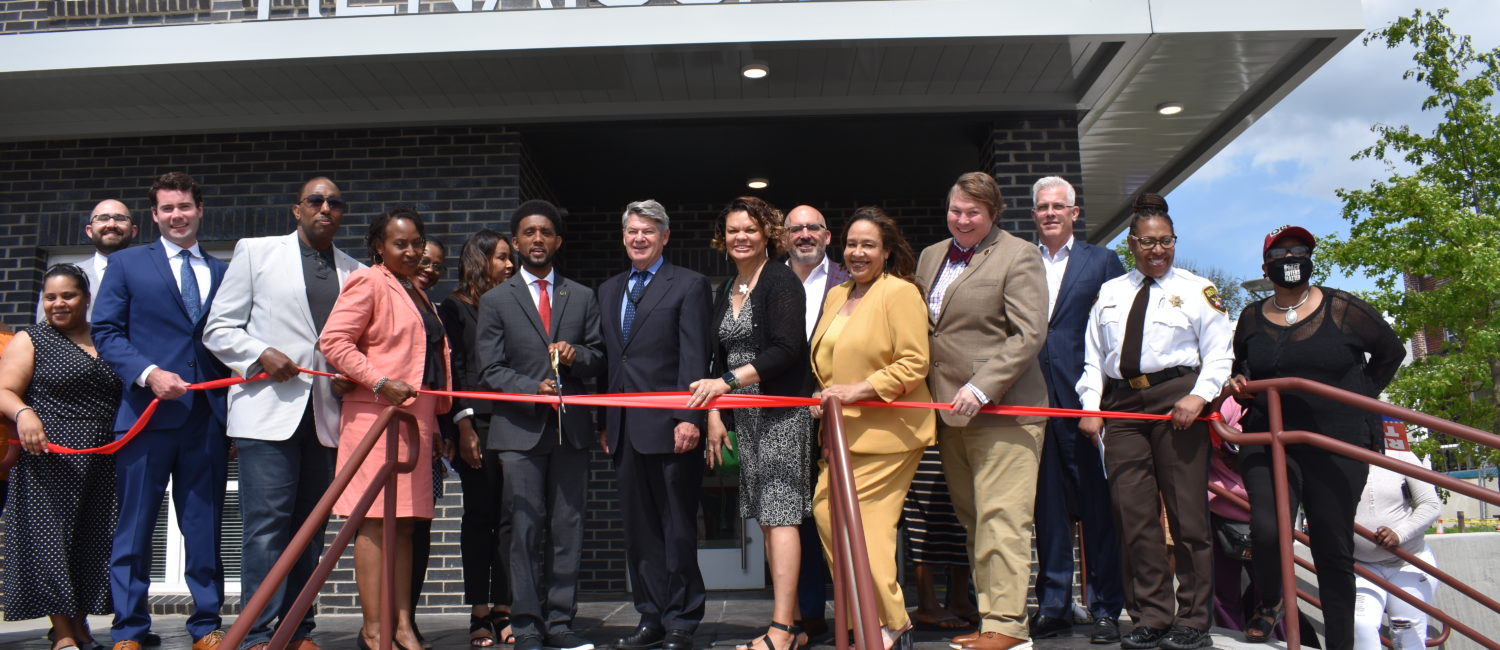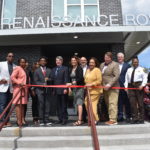“Lord, we ask that you will bless the staff, bless all of those that will come in to get services, let them continue to do the work … Bless this like never before, grant all of this in Jesus’ name.”
These were the words spoken by Pastor Tory Randall that christened the Renaissance Row, an 84-unit affordable apartment building that officially opened in Baltimore’s Park Heights neighborhood on Thursday. The ribbon-cutting, attended by Baltimore Mayor Brandon Scott, a native of Park Heights himself, as well as other city leaders and officials, marked the beginning of what many in the community hope will be a long-awaited rebirth for the area.
Along with the city leaders, building residents gathered to celebrate their new home’s grand opening. Acie Lyons, 21, a west Baltimore native, called his second-floor apartment “lovely” and said he appreciated that the building was located near a metro stop.
“It’s a pretty cool experience. It comes with a gym and everything, so I really love it,” said Lyons, who is transitioning from an independent living program for former foster care youth to his first apartment under his own name. “I walk around the premises sometimes when it’s sunny outside. It’s really nice.”
The planned revitalization is spearheaded by Park Heights Renaissance, a community organization which claims the project is the largest urban renewal effort in the state of Maryland; the neighborhood comprises 1,500 acres and over 25,000 residents, per the most recent census.
It’s also a project that has been in the works for years. A Park Heights masterplan, commissioned by several Baltimore agencies, was first published in 2006 and revised two years later. The plan outlines goals for refurbishing and repurposing vacant space, establishing new retail centers, building new housing and finding ways for Pimlico to contribute and connect more to the surrounding community.
Now, more than a decade later, many of these projects are finally underway, including the Pimlico renovation, which is scheduled to begin construction in 2023, and a number of new housing developments, including the aptly named Renaissance Row.
The building, which was developed by Philadelphia-based Pennrose, who also manages the property, includes one-, two-, and three-bedroom apartments. Seventy-six of those units are set aside for occupants who make 60% or less than the area’s median income. The remaining eight require 30% of the median income or less.
The journey to construct the building, which is located at 4301 Park Heights Ave., was a laborious one. According to Ivy Dench-Carter, senior vice president of development for Pennrose, supply chain issues so impaired the project’s construction company that they had to travel to Home Depot stores in different states just to get toilets for each unit. Setbacks also included concerns about whether the area’s sewer system could handle the construction.
“I just wanted to share those stories to let you guys know as a community, we do work very hard with our partners at the city to get things done,” she said. “It takes a little while, but it finally does happen.”
Overall, the project cost $21.5 million, funded through state loans, tax credits and bonds; loans from the city of Baltimore; a payment in lieu of taxes; and a seller-take back note for the land purchase. M&T Bank also contributed $7 million to the project through the purchase of tax credits.
Other housing projects in the neighborhood are also well underway. Ground was broken on Woodland Gardens II, an affordable housing development for seniors, on Friday. A project to fix homes on four blocks on Loyola Northway has already been launched, resulting in six homes being refurbished and sold thus far. A transit-oriented development, to be built on West Cold Spring Lane across from the neighborhood’s metro station, is also in the works.
According to Yolanda Jiggetts, executive director of Park Heights Renaissance, this surge of development has long been in the works — something that has at times frustrated community members and left them wondering when the long-anticipated revitalization would begin.
“We go back all the way to 2006, (and the) community leaders and residents that were involved, they were excited for this renaissance of park heights. 2006 to now is a long time,” Jiggetts said. But now, “all of this talk is really happening.”
She also expects the success of Renaissance Row will help draw more developers to the area.
Andrew Hanson, vice president of development for Conifer Realty LLC, the firm behind the upcoming West Cold Spring Lane project, agreed, stating that Park Heights is well situated to support more development thanks to its proximity to transit, as well as grocery stores and other amenities.
“All of the core, necessary ingredients are there with transportation, population, infrastructure,” Hanson said.
Plus, the city is invested in its success. At Renaissance Row’s opening, Scott committed $14 million toward implementing the Park Heights master plan, from $100 million in American Rescue Plan Act funds that the city is putting toward housing initiatives. He also announced that the city would put $3 million toward creating a new Enoch Pratt Free Library branch in the neighborhood.
Moving forward, Park Heights Renaissance, which now occupies a brand-new office space in the Renaissance Row building, hopes to develop a more comprehensive implementation plan for the neighborhood’s development in the coming years.
So, what is Park Heights Renaissance going to work on next? As Stewart put it in an interview with The Daily Record: “The better question is, is there anything Park Heights Renaissance, led by Yolanda, isn’t doing?
Originally Posted on The Daily Record and written by By Johanna Alonso




